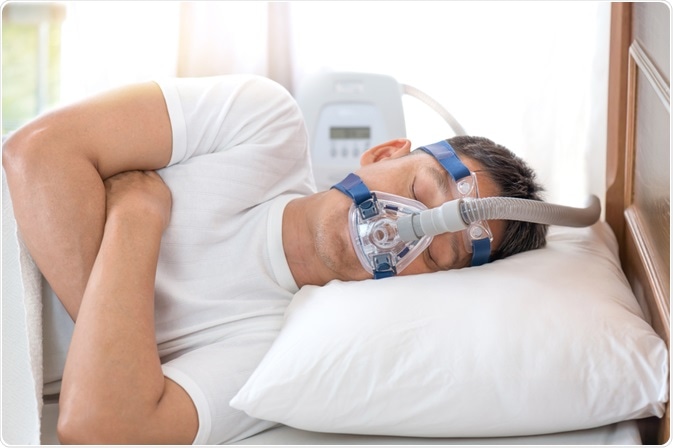Snoring causes distress and lack of sleep for both the snorer and anyone who shares the same room. In addition, it has been linked to many metabolic disorders, including cardiovascular disease.
 Image Credit: sbw18/Shutterstock.com
Image Credit: sbw18/Shutterstock.com
Treatments for snoring can be either surgical or non-surgical; which type is adopted depends on the etiology of the snoring.
Nasal snoring
Inspiration is characterized by the creation of negative pressure and partial collapse of the pharyngeal airway, in snorers. The reason for the snoring is the obstruction of the upper airway. Nasal devices may help keep it open and relieve snoring. The Afrin test is one method of identifying patients who may benefit from these devices.
Nasal snoring is often helped by the use of nasal anti-snoring devices, namely, nasal strips or nasal dilators. These both keep the nostrils open during sleep.
Nasal strips are self-adhesive tape strips designed to pull the nostrils apart.
Nasal dilators are made of plastic or metal and function by pushing the nostrils open during sleep. Either of these may be used as their efficacy has not been directly compared.
Obstructive sleep apnea syndrome (OSAS)
OSAS may be treated by one of several modalities:
- Continuous positive airway pressure (CPAP)
- Oral appliances
- Surgery
Oral appliances
Oral appliances may be used instead of CPAP, or if the latter fails or is not acceptable to the patient. They may also be indicated in mild or moderate OSAS without daytime sleepiness.
Chin strips
Chin strips are self-adhesive tape strips fastened under the chin to keep the mouth closed during sleep.
Vestibular shield
This plastic device is fitted inside the mouth to obstruct airflow through it and promote nasal breathing, which often prevents snoring.
Both these devices are comparable in terms of available research.
Mandibular advancement devices (MAD)
These devices are used to prevent snoring caused by vibration of the base of the tongue. They push the lower jaw and tongue forward to increase the space for airflow in the pharynx, thereby preventing the vibration of the tongue in this region.
A thermoplastic MAD may be bought ready-made and fitted to size in the patient’s home. These devices may not be suitable for or tolerated by individuals with a strong gag reflex, or those who cannot sleep with appliances in the mouth. It may cause pain in the face and jaw over the initial days. A custom-made MAD by a dentist is recommended for those with OSAS, however, these are much more expensive.
Modern MAD are lighter, less bulky, and even micro-adjustable, which allows each person to adjust the amount of jaw protrusion to stop snoring without causing undue stress on the jaw and facial muscles. Such devices will need to be replaced about once in 18 months.
Tongue-retaining devices (TRD)
The TRD is another oral appliance that prevents the falling back of the tongue that often occurs during sleep and causes snoring in many individuals. It holds the tip of the tongue in place through a slight negative suction. The associated mouthpiece creates mandibular protrusion as well, but this is reduced to comfortable levels based upon patient feedback.
This can also be increased if snoring continues despite its use. The TRD has orifices laterally to allow mouth breathing in case the nose is blocked. This may create some initial soreness, but it is quite safe and reported to be effective in many snorers. Furthermore, it reduces sleep apnea and daytime somnolence.
Advantages and disadvantages of oral appliances
Oral appliances can cause discomfort, foreign body sensation, excessive salivation or mouth dryness. They should typically be used after a sleep study has been performed to identify the risk factors for OSAS and to diagnose it, if present, as well as to provide a baseline to assess progress with the use of the appliances. They are reversible, simple to use, affordable, and effective, and so offer an alternative to CPAP in many patients.
Adjustable oral appliances require orthodontic skills and are, therefore, much more expensive than fixed appliances. They take more time to fashion, and tolerance buildup is slower; however, they are more effective in reducing snoring among all types of patients with OSAS. The highest success rates are found in younger patients with a slimmer build and lower BMI, who have mild to moderate OSAS.
Fixed appliances are relatively more inexpensive, easy to fit by the patient, and act faster. They cannot be adjusted to provide greater or less mandibular protrusion and thus fail to correct snoring.
As a whole, oral appliances are more acceptable than CPAP in individuals with OSAS.
A more recent device is based upon the ability to learn a conditioned reflex. It starts to vibrate with the onset of snoring, which provokes the sleeper to turn on to the side. It helps to improve daytime sleepiness, without affecting or improving sleep quality.
References
Further Reading